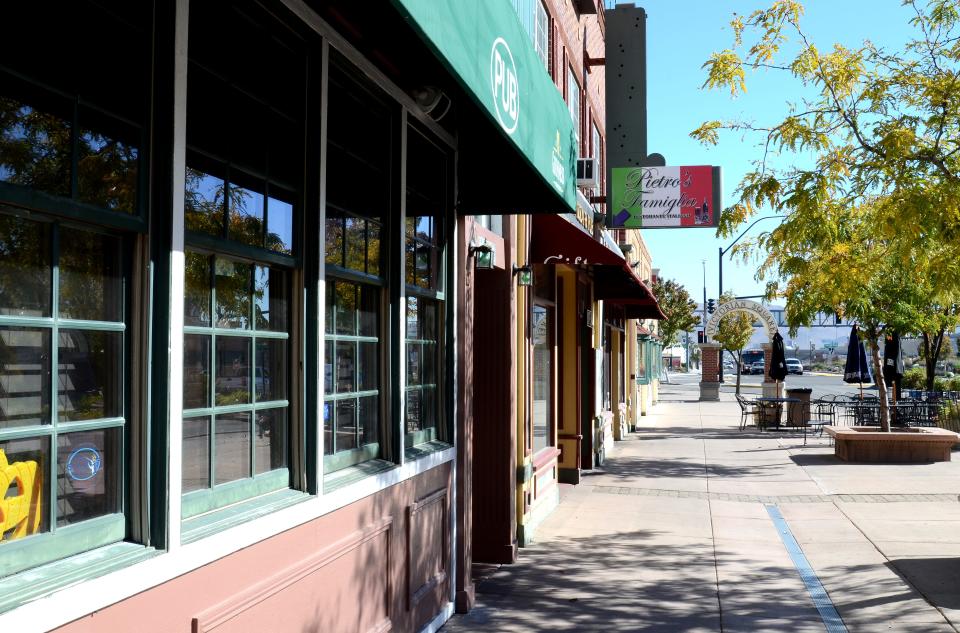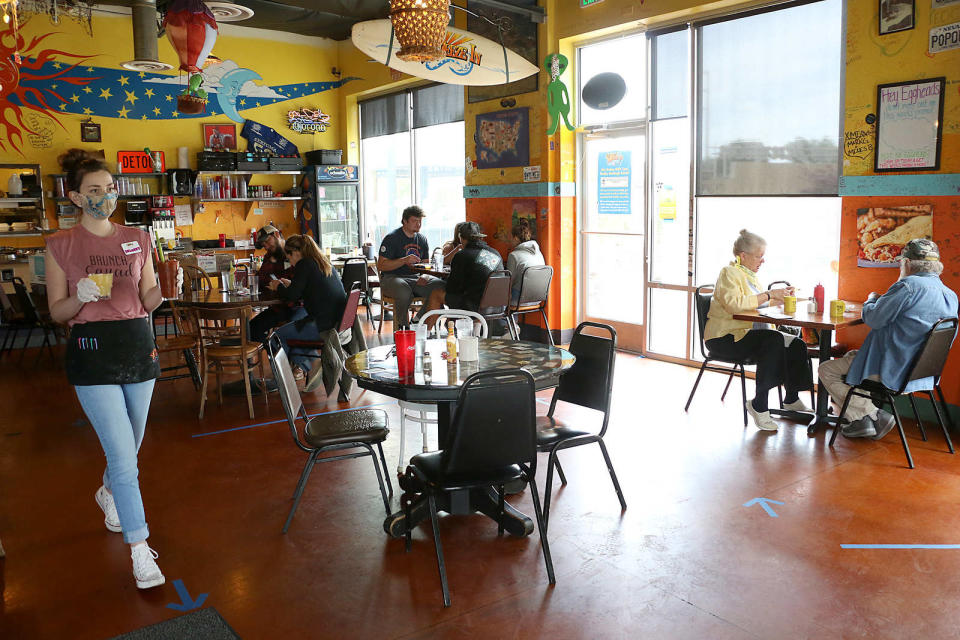COVID-19 relief: Here’s a list of pandemic relief programs for small businesses
Despite the improved numbers for new cases and deaths compared to the peak of the pandemic, COVID-19 continues to have an outsized impact on small businesses.
The passage and signing of the American Rescue Plan in March kicked off another round of funding for COVID relief, which includes several assistance programs for small businesses. While this is good news for struggling business owners, many either don’t apply or underestimate the amounts that they qualify for, said Kayla Banda, a business development advisor with the Nevada Small Business Development Center.
Some business owners and independent contractors don’t even know that relief options exist, especially smaller assistance programs run by local and state entities.
For local stories that matter, subscribe today.
“The big thing is that a lot of businesses don’t know that they can qualify for assistance,” Banda said.
“I’ve talked to clients who had no idea that they could actually qualify as a new business, for example. I’ve also had clients who left money on the table when they could’ve gotten more.”
This makes it especially important for small business owners to not just keep tabs on the various assistance programs but also educate themselves about the benefits they can receive. Business owners should also move quickly as funding will eventually run out, particularly given the high demand for these programs.
For subscribers: Shell company transparency law takes aim at a key Nevada industry. Will it have an impact?
Here is a quick rundown of the various pandemic assistance programs available for businesses.

Paycheck Protection Program
The PPP, which is overseen by the Small Business Administration, is arguably the most widely known pandemic relief program for businesses. It’s designed to incentivize small businesses to keep workers on the job by providing funding for payroll.
The biggest draw of this program is that while it is technically a loan, borrowers can have the amount written off if they apply for forgiveness within 10 months of the last covered period of their agreement. It’s basically free assistance for those who qualify for it.
Also, while the PPP is designed as a payroll assistance program, it can also apply to small businesses that do not have any employees.
“Some people like sole proprietors and independent contractors think that, ‘Oh, I don’t have payroll because I don’t have any employees so I can’t qualify,’ which is totally not true,” Banda said. “If you receive a Schedule C (profit or loss form from the IRS) … you can actually use that to calculate your loan amount.”
For more details about the program, including help for finding a qualified lender, visit the SBA’s official PPP website. Otherwise, call your local SBA District office for more details. In Northern Nevada, the number is 775-885-7647.
Economic Injury Disaster Loan
Also known as EIDL, this is another program overseen by the SBA and provides economic relief for small businesses as well as nonprofits that have suffered from a temporary loss of revenue. The assistance can be used to pay for financial obligations or operating expenses that a business would have been able to cover on its own had the pandemic not occurred.
Like the PPP, this program has been around for a while but has one key difference.
“It’s not forgivable,” Banda said. “But it’s still a pretty good option for businesses.”
Borrowers can apply for both the PPP and EIDL, but funds from both are not allowed to be used for the same purpose. Applicants also must be physically located in the United States and have fewer than 500 employees.
The maximum loan amount is $150,000, with loans above $25,000 requiring collateral. The interest rate is 3.75% for businesses and 2.75% for nonprofits, with payment terms up to 30 years.
For more information or to apply for a loan, visit the SBA’s official EIDL website.
Shuttered Venue Operators Grant
Known as SVOG for short, this program was amended by the American Rescue Plan and provides more than $16 billion in grants to venues that have been closed due to COVID-19. Of that number, $2 billion is set aside for smaller operations with 50 employees or less.
Applicants that qualify for the program will receive grants equal to 45% of their gross revenue. The maximum grant amount for one applicant is $10 million.
Entities that are eligible for the Shuttered Venue Operators Grant include:
Live venue operators or promoters
Theatrical producers
Live performing arts organization operators
Relevant museum operators, zoos and aquariums who meet specific criteria
Motion picture theater operators
Talent representatives
Note that booking agencies can qualify even if they don’t operate a venue.
“They can qualify if 70% or more of their annual revenue comes from booking the talent for the venues,” Banda said.
Keep in mind, however, that while it’s possible to receive assistance via the SVOG grant after getting PPP assistance, the reverse is not true, Banda warned.
“If you apply for the SVOG, you can no longer apply for the PPP so people need to get their PPP first before applying for the SVOG,” Banda said.
For more information or to apply, visit the SBA’s official SVOG site.
Restaurant Revitalization Fund

This $26.5 billion fund was established by the American Rescue Plan for food and drink establishments. The program, which will be awarded by the SBA, will set aside $5 billion of its funds for smaller businesses with gross revenues of less than $500,000. There will be a cap of $10 million for each business, including $5 million for each of a business's physical locations.
According to the American Rescue Plan, businesses that can apply for the Restaurant Revitalization Fund include:
Restaurants
Food trucks
Food stands
Food carts
Caterers
Inns
Saloons
Taverns
Bars
Lounges
Brewpubs
Taprooms
Tasting rooms
Publicly-traded companies are ineligible, which is good news for smaller operations that were squeezed out by large chains during the first round of PPP funding.
Funds will be allocated within phases, with businesses that lost a larger percentage of revenue being prioritized. The RRF will also give higher priority to small businesses run by women, veterans and socially and economically disadvantaged proprietors.
“That’s good because my initial concern was that big restaurants will go in and just eat up those funds,” Banda said. “Eligibility for the program is so open and broad.”
According to the National Restaurant Association, eligible businesses “may receive a tax-free federal grant equal to the amount of its pandemic-related revenue loss, calculated by subtracting its 2020 gross receipts from its 2019 gross receipts.”
If you already received PPP funding, that amount will be deducted from your eligibility for the RRF.
As of early April, an official date has not been announced for program applications but it should be included in the SBA’s main COVID relief operations site once it is available.
SBA Debt Relief
The SBA Debt Relief Program provides financial assistance for borrowers of three types of SBA loans:
7(a)
504
Microloans
As part of the program, the SBA will pay six months of principal, interest, and any associated fees owed by borrowers for such loans that are in “regular servicing status.” The assistance will be automatically provided without needing an application and will apply to loans that were approved up to September 27, 2020.
Coronavirus Food Assistance Program 2

This program is administered by the USDA and was re-launched on April 5 after signups ended on Dec. 11. The program provides financial assistance to farmers, ranchers and other producers to absorb increased costs from market disruptions caused by the pandemic. Assistance is based on the type of commodities grown or raised by farmers and ranchers.
Commodities that are eligible for Coronavirus Food Assistance Program 2 assistance include:
Specialty crops
Livestock
Dairy
Row crops
Aquaculture
Floriculture
Nursery crops
The launch of CFAP 2 coincides with an increase in payment rates for commodities such as cattle under the original CFAP program.
“We did what we call additional top-up payments to folks who were already signed up and each commodity had a payment rate,” said Gus Wegren, acting state executive director for the USDA Farm Service Agency in Nevada. The first CFAP round accounted for nearly $26.7 million in payments for Nevada producers alone and more than $1.2 billion in California.
The USDA also expects to make $4.5 billion in payments to 560,000 producers as part of new CFAP 2 funding that pays $20 in assistance per acre. Total funds for the second round of CFAP 2 funding amounts to about $6 billion, Wegren said. There is a payment limit of $250,000 for each applicant but exceptions also exist for legal entities that have multiple members that provide active labor or personnel management. Examples include cattle operations that are set up as limited liability companies.
“If they can prove that each member provided at least 400 hours of active personal labor or management, then they can get $500,000 for two members or $750,000 for three members,” Wegren said.
COBRA Premium Assistance
This program provides insurance assistance to employees who lost their coverage and the subsidy will come in the form of a payroll tax credit for employers. As part of the American Rescue Plan, the Department of Labor announced on April 7 that the federal government will provide eligible employees who lost their healthcare coverage a 100% subsidy on their COBRA insurance premiums between April 1 and Sept. 30.
For more details, visit the Department of Labor’s COBRA Premium Subsidy web page.
Jason Hidalgo covers business and technology for the Reno Gazette Journal, and also reviews the latest video games. Follow him on Twitter @jasonhidalgo. Like this content? Support local journalism with an RGJ digital subscription.
This article originally appeared on Reno Gazette Journal: COVID relief for small business: Here’s a list of assistance programs.

 Yahoo Finance
Yahoo Finance 